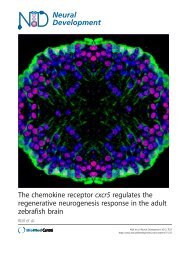Neural Development - BioMed Central
Neural Development - BioMed Central
Neural Development - BioMed Central
You also want an ePaper? Increase the reach of your titles
YUMPU automatically turns print PDFs into web optimized ePapers that Google loves.
<strong>Neural</strong> <strong>Development</strong> 2009, 4:1<br />
http://www.neuraldevelopment.com/content/4/1/1<br />
retinal ganglion cells are the first cell type to be determined,<br />
at around stage 27/28, while bipolar and Müller<br />
glial cells are the last to be determined at around stage 37/<br />
38.<br />
In the retina, differentiation of neurons and glial cells is<br />
preceded by cell cycle exit of the progenitors during early<br />
G1 phase. The fate of each cell type appears to be influenced<br />
during the final cell cycle [5-8]. Insufficient accumulation<br />
of a cell fate determinant in the last cell cycle<br />
allows cell cycle progression without determination [9].<br />
G1-phase cell cycle components, such as cyclin Ds, have<br />
important roles in the choice between continuous proliferation<br />
and cell fate determination [10]. Cells arrested in<br />
early G1 are more likely to be influenced by determinants<br />
than cycling cells, while cell cycle activation tends to<br />
inhibit the activity of determinants [8]. In addition, many<br />
determinants have the ability to induce cell cycle exit in<br />
G1 [2,11,12], suggesting bi-directional communication<br />
between cell cycle components and determinants.<br />
p27Xic1 is a Xenopus member of the Cip/Kip cyclin<br />
dependent kinase (CDK) inhibitor (CDKI) family that<br />
promotes Müller glial cell fate determination in the retina<br />
[13]. The Cip/Kip CDKI family has a conserved CDK/cyclin<br />
binding domain in its amino terminus and memberspecific<br />
sequences in the carboxyl terminus. p27Xic1 activates<br />
gliogenesis through its amino terminus but in a cell<br />
cycle regulation-independent manner. However, in the<br />
presence of proneural genes, such as Xath5, p27Xic1<br />
potentiates the activities of proneural genes [8]. A similar<br />
neurogenic activity of p27Xic1 has been demonstrated in<br />
Xenopus primary neurogenesis [14,15] and is also mediated<br />
through the amino terminus of the protein. Also,<br />
p57Kip2 influences specification of amacrine cell subtypes<br />
in the mouse retina [16]. All these observations indicate<br />
that the Cip/Kip CDKIs regulate both gliogenesis and<br />
neurogenesis through their amino termini in a contextdependent<br />
manner. Recently, this dual role has been demonstrated<br />
in the mammalian system as well. Mouse retinal<br />
progenitors lacking Math5, a determinant of retinal ganglion<br />
cells, upregulate p27Kip1 and differentiate into<br />
Müller glial cells [17]. Furthermore, CDKIs regulate differentiation<br />
processes through regulation of actin and microtubule<br />
structure [18-22]. These activities are mediated by<br />
direct interaction between the carboxyl termini of CDKIs<br />
and the regulators of cytoskeletal structures. These observations<br />
indicate that CDKIs have three independent activities:<br />
cell cycle regulation, cell fate determination, and<br />
regulation of cytoskeletal structures. Previous work has<br />
shown that the amino terminus of p27Xic1 promotes<br />
neurogenesis by stabilizing neurogenin [14], but this<br />
mechanism cannot explain how p27Xic1 promotes glial<br />
rather than neuronal fate in the retina. To address this<br />
conflict, we have screened for proteins that interact with<br />
the amino terminus of p27Xic1 and regulate its gliogenic<br />
activity in the Xenopus retina. Here, we identify NM23-X4<br />
as a binding partner of p27Xic1 and show that NM23-X4<br />
regulates gliogenic activity of p27Xic1 in Xenopus retinogenesis.<br />
Results<br />
Identification of NM23-X4 as a novel binding protein of<br />
p27Xic1<br />
To identify proteins that interact with the amino terminus<br />
of p27Xic1, we performed bacterial two-hybrid screening<br />
using a Xenopus two-hybrid library (3 × 10 6 clones) and<br />
the amino terminus (1–96 amino acids) of p27Xic1 as<br />
bait. One of the positive hits encodes a protein sequence<br />
with high homology to NM23 proteins. The NM23 family<br />
consists of nucleotide diphosphate kinases (NDPKs),<br />
which exchange -phosphate between nucleotide triphosphate<br />
and diphosphate [23]. Ten members are known to<br />
comprise the human family (NM23-H1 to -H9 and RP2).<br />
Apart from NDPK activity, NM23-H1 and -H2 have been<br />
shown to possess additional activities, such as serine/threonine<br />
kinase, histidine dependent kinase, transcription<br />
factor, 3'-5' exonuclease, and apoptosis induced DNase<br />
activities (for reviews, see [24,25]). Although mouse<br />
NM23-M1 is highly expressed in the central nervous system<br />
[26], very little is known about the role of NM23<br />
members in neurogenesis and gliogenesis. We have identified<br />
five novel Xenopus members of the NM23 family by<br />
searching the Xenopus EST database in addition to three<br />
already known NM23 members [27]. Sequence alignment<br />
revealed that our identified clone has the highest homology<br />
with the human NM23-H4 and we thus named it<br />
NM23-X4 (Figure 1A–B).<br />
Interaction between NM23 and CDKIs<br />
Identification of NM23-X4 as a binding partner of<br />
p27Xic1 by two-hybrid screening prompted us to verify<br />
this interaction in cells. We were able to confirm this protein-protein<br />
interaction by immunoprecipitation after<br />
transfection of tagged expression constructs in COS7 cells.<br />
Initially, as shown in Figure 2A, immunoprecipitation of<br />
NM23-X4 with p27Xic1 produced an extremely weak<br />
band (lane 3). Since p27Xic1 is an unstable protein,<br />
which is degraded by the proteasome [28], we analyzed<br />
the interaction in the presence of a proteasome inhibitor<br />
MG132. Lane 5 shows a strong band corresponding to<br />
p27Xic1, indicating that indeed NM23-X4 binds to<br />
p27Xic1. Also, we analyzed the effect of AMP-PNP, a nonhydrolysable<br />
analogue of ATP that stabilizes interactions<br />
between NM23-H1 and the kinase suppressor of Ras [29].<br />
However, AMP-PNP did not have any effect on p27Xic1<br />
interaction with NM23-X4. All the following immunoprecipitation<br />
experiments were performed in the presence of<br />
MG132 unless otherwise stated.<br />
Page 2 of 18<br />
(page number not for citation purposes)




